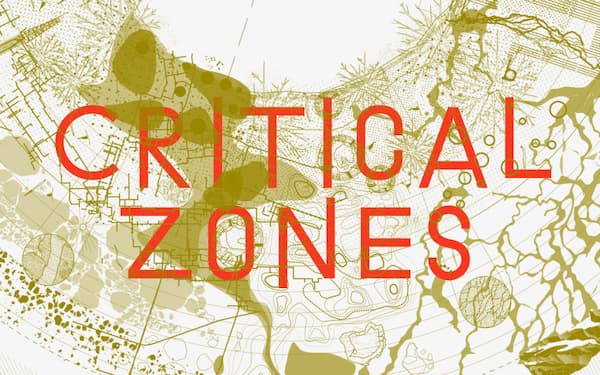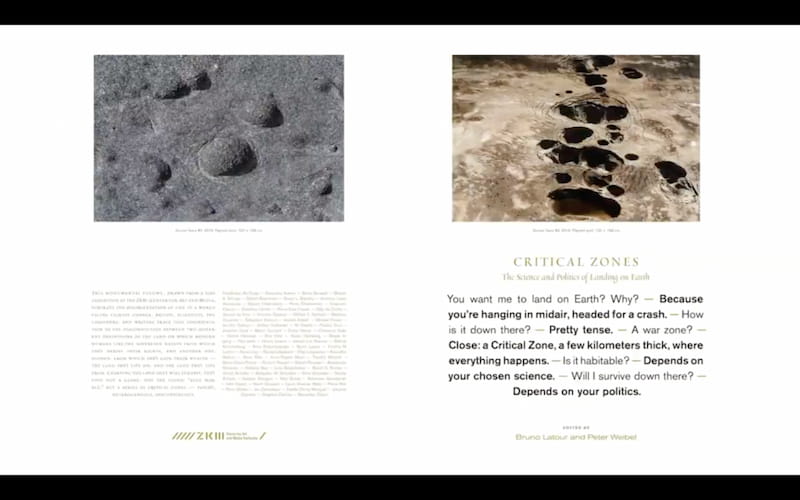Online launch of “Critical Zones” exhibition at ZKM
May 22, 2020

This weekend sees the online launch of “Critical Zones – Observatories for Earthly Politics” at ZKM Center for Art and Media in Germany, co-curated by Bruno Latour, Peter Weibel, Martin Guinard and Bettina Korintenberg.
I’ve contributed a chapter on “The Datafication of Forests? From the Wood Wide Web to the Internet of Trees” to the accompanying book Critical Zones: The Science and Politics of Landing on Earth (forthcoming on MIT Press). You download an open access preprint of my chapter here and the final version here (PDF). Here’s the abstract:
How can data and networked digital technologies be used to cultivate collective sensibilities towards the presence of trees? How can the datafication of forests build on or depart from other ways of relating to trees, whether through mythology, mapping, camping, conservation, literature, logging, painting, planting, film, food, art installations, activist occupations, imperial expansion, indigenous stewardship, botany, birthing, or bathing (shinrin-yoku)? This piece briefly explores some of the emerging practices, infrastructures, and devices that are used to render trees experiencable, sensible, and relatable through digital data.

To mark the opening of the exhibition there is a free virtual opening and streaming festival, including guided tours, interviews, talks, discussions, film screenings and more – with Bruno Latour, Donna Haraway, Peter Weibel, Jennifer Gabrys, Eyal Weizman, Alexandra Arènes, Soheil Hajmirbaba, Marie-Claire Pierret, Jan Zalasiewicz, Bettina Korintenberg, Barbara Kiolbassa, Tim Lenton, Sébastien Dutreuil, Simon Schaffer, Joseph Leo Koerner, Ali Gharib, Dipesh Chakrabarty, Emanuele Coccia, Vinciane Despret, Frédérique Aït-Touati, Adam G. Riess, Bruce Clarke, John Feldman and many others. This includes free online screenings of Donna Haraway: Story Telling for Earthly Survival by Fabrizio Terranova and Symbiotic Earth: How Lynn Margulis Rocked the Boat and Started a Scientific Revolution by John Feldman. You can find the programme here, the livestream here, the digital edition of the exhibition here.

Following is the abstract for the book:
Artists and writers portray the disorientation of a world facing climate change.
This monumental volume, drawn from a 2020 exhibition at the ZKM Center for Art and Media, portrays the disorientation of life in a world facing climate change. It traces this disorientation to the disconnection between two different definitions of the land on which modern humans live: the sovereign nation from which they derive their rights, and another one, hidden, from which they gain their wealth—the land they live on, and the land they live from. Charting the land they will inhabit, they find not a globe, not the iconic “blue marble,” but a series of critical zones—patchy, heterogenous, discontinuous.
With short texts, longer essays, and more than 500 illustrations, the contributors explore the new landscape on which it may be possible for humans to land—what it means to be “on Earth,” whether the critical zone, the Gaia, or the terrestrial. They consider geopolitical conflicts and tools redesigned for the new “geopolitics of life forms.” The “thought exhibition” described in this book opens a fictional space to explore the new climate regime; the rest of the story is unknown.
Contributors include
Dipesh Chakrabarty, Pierre Charbonnier, Emanuele Coccia, Vinciane Despret, Jerôme Gaillarde, Donna Haraway, Joseph Leo Koerner, Timothy Lenton, Richard Powers, Simon Schaffer, Isabelle Stengers, Bronislaw Szerszynski, Jan A. Zalasiewicz, Siegfried Zielinski.
Following is the overview of the exhibition:
Over a period of several months ZKM will host an exhibition conceived as a scale model to simulate the spatial novelty of this new land as well as the diversity of relations between the life forms inhabiting it. It will serve as an OBSERVATORY OF CRITICAL ZONES allowing visitors to familiarize themselves with the new situation. This special combination of thought experiment and exhibition was developed by Peter Weibel and Bruno Latour in their previous collaborations at ZKM. »Iconoclash« in 2002, »Making Things Public« in 2005, and »Reset Modernity!« in 2016 constitute the three former »thought exhibitions« (Gedankenausstellungen) that resulted from their intensive working relationship which now spans twenty years.For a long time the reactions of Earth to our human actions remained unnoticed, but in recent times with the protest movement Fridays for Future climate crisis has moved into public consciousness. The thought exhibition »CRITICAL ZONES« invites us to deal with the CRITICAL situation of the Earth in various ways and to explore new modes of coexistence between all forms of life.
By now everybody knows that there is an existential threat to our collective conditions of existence, but very few people have any idea of how to cope with this new CRITICAL situation. The citizens of many developed countries appear disoriented; it is as if they were asked to land on a new territory – a new Earth – whose reactions they have ignored for a long time.
The Earth as a network of CRITICAL ZONES
The hypothesis we want to propose is that the best way to map this new Earth is to see it as a network of CRITICAL ZONES. Generated over eons of time by various life forms, these CRITICAL ZONES form a surface only a few kilometers thin. Those life forms had completely transformed the original geology of the Earth, before humanity transformed it yet again over the last centuries.
Over the years, scientists have installed multiple OBSERVATORIES to study these CRITICAL ZONES and have made us aware of the complex composition and extreme fragility of this thin layer inside which all life forms, humans included, have to cohabit. They have renewed Earth science in a thousand ways and very much in a way that Alexander von Humboldt would have approved.
A new turn towards the EARTHLY
Increasingly, scientists, artists, activists, politicians, and citizens are realizing that society is not centered solely on humanity, but it has to become EARTHLY again if it wishes to land without crashing. The modern project has been in flight, unconcerned by planetary limits. Suddenly, there is a general movement toward the soil and new attention to the ways people might inhabit it. POLITICS is no longer about humans making decisions on their own and for themselves only, but has become an immensely more complex undertaking. New forms of citizenship and new types of attention and care for life forms are required to generate a common ground.
The exhibition as an OBSERVATORY OF CRITICAL ZONES
Over a period of several months ZKM will host an exhibition conceived as a scale model to simulate the spatial novelty of this new land as well as the diversity of relations between the life forms inhabiting it. It will serve as an OBSERVATORY OF CRITICAL ZONES allowing visitors to familiarize themselves with the new situation. This special combination of thought experiment and exhibition was developed by Peter Weibel and Bruno Latour in their previous collaborations at ZKM. »Iconoclash« in 2002, »Making Things Public« in 2005, and »Reset Modernity!« in 2016 constitute the three former »thought exhibitions« (Gedankenausstellungen) that resulted from their intensive working relationship which now spans twenty years.